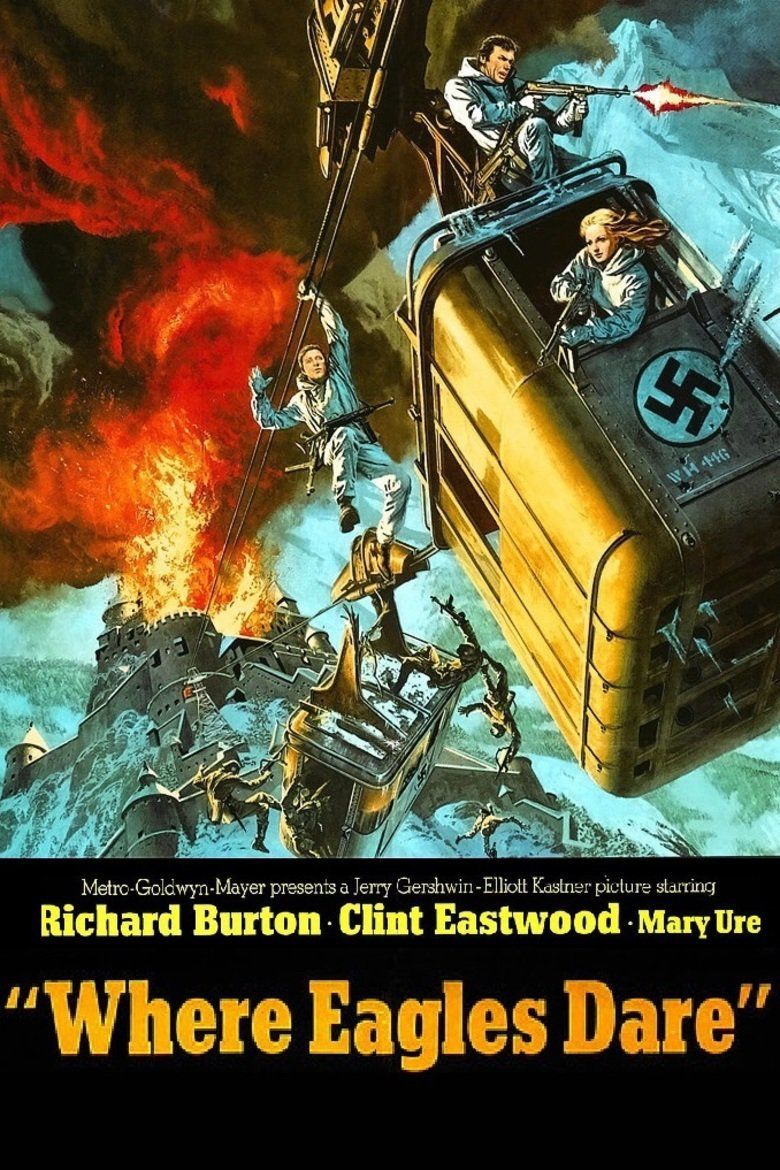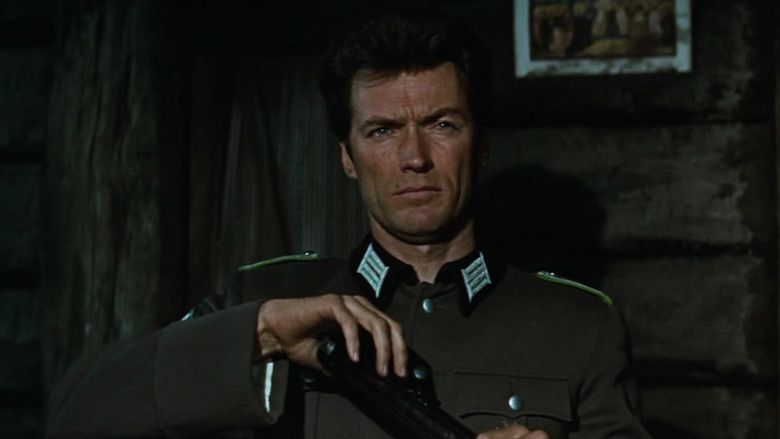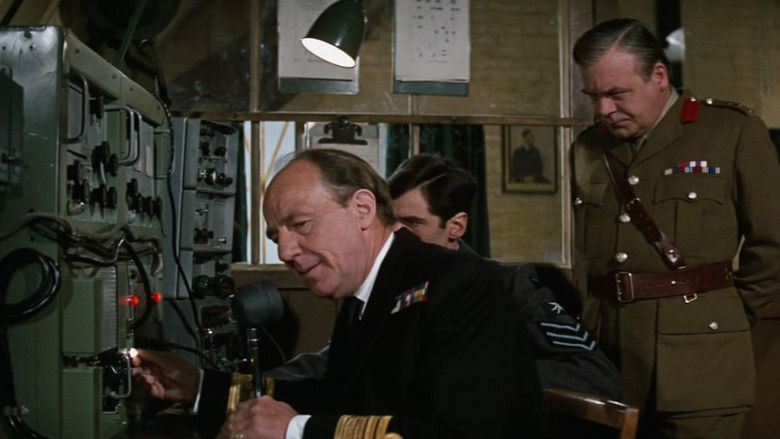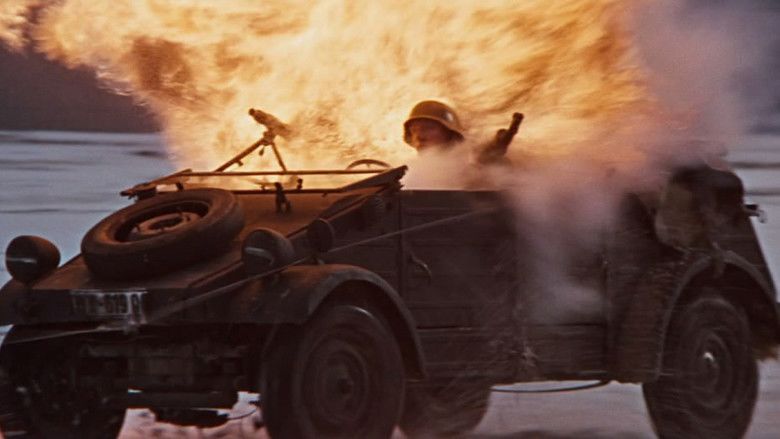Where Eagles Dare
7.8 /10 1 Votes
Country United Kingdom | 7.8/10 IMDb Genre Action, Adventure, War Duration Language English | |||||||||||||||||||||||||||||||||
 | ||||||||||||||||||||||||||||||||||
Release date 4 December 1968 (1968-12-04) (UK)12 March 1969 (1969-03-12) (US) Based on Where Eagles Dare by Alistair MacLean Writer Alistair MacLean (story), Alistair MacLean (screenplay) Initial release December 4, 1968 (United Kingdom) Cast (Maj. Jonathan Smith, MC), (Lt. Morris Schaffer), (Mary Elison), (Col. Wyatt Turner, DSO MC), (Adm. Rolland), (Christiansen) Similar movies Hell Is for Heroes , Fury , When Trumpets Fade , None But the Brave , The Thin Red Line , The Great Escape Tagline They dare to climb a terrifying new peak in suspense... all the way up to hell! | ||||||||||||||||||||||||||||||||||
Where eagles dare official trailer 1 clint eastwood movie 1968 hd
Where Eagles Dare is a 1968 British World War II action film from Metro-Goldwyn-Mayer that stars Richard Burton, Clint Eastwood, Mary Ure, and Ingrid Pitt. It was directed by Brian G. Hutton and shot on location in Austria and Bavaria. Alistair MacLean wrote the novel of the same name and the screenplay at the same time. It was his first screenplay; both film and book became commercial successes.
Contents
- Where eagles dare official trailer 1 clint eastwood movie 1968 hd
- Where eagles dare 1968 trailer
- Plot
- Production
- Filming
- Historical inaccuracies
- Reception
- Soundtrack
- Novel
- References

The film involved some of the top moviemaking professionals of the day and is now considered a classic. Major contributors included Hollywood stuntman Yakima Canutt, who as second-unit director shot most of the action scenes; British stuntman Alf Joint who doubled for Burton in such sequences as the fight on top of the cable car; award-winning conductor and composer Ron Goodwin, who wrote the film score; and future Oscar-nominee Arthur Ibbetson, who worked on its cinematography. The film is noted for the phrase "Broadsword calling Danny Boy", spoken by Richard Burton several times throughout. The phrase is frequently used by Richard Burton impressionists.

Where eagles dare 1968 trailer
Plot

In the winter of 1943–44, U.S. Army Brigadier General George Carnaby (Robert Beatty), a chief planner for the second front, is captured by the Germans when his air transport to Crete is shot down. He is taken for interrogation to the Schloß Adler, a mountaintop fortress in the Alps of southern Bavaria, accessible only by cable car or helicopter. A team of seven Allied commandos, led by British Major John Smith of the Grenadier Guards (Richard Burton) and U.S. Army Ranger Lieutenant Morris Schaffer (Clint Eastwood), is briefed by Colonel Turner (Patrick Wymark) and Admiral Rolland (Michael Hordern) of MI6. Disguised as German troops, they are to parachute in, enter the castle, and rescue General Carnaby before the Germans can interrogate him. After their German Ju-52 transport drops them in Germany, Smith secretly meets Mary Ellison (Mary Ure) and Heidi Schmidt (Ingrid Pitt), their presence known only to him; Heidi arranges for Mary to be a maid at the castle.

Although two of the team are mysteriously killed, Smith continues the operation, keeping Schaffer as a close ally and secretly updating Rolland and Turner by radio. The commandos surrender themselves to the Germans; Smith and Schaffer (being officers) are separated from the other three operatives, Thomas (William Squire), Berkeley (Peter Barkworth), and Christiansen (Donald Houston). Smith and Schaffer quickly kill their captors, blow up a supply depot, and prepare an escape route for use at the end of their mission. They reach the castle by riding on the roof of a cable car, and climb inside when Mary lowers a rope.

German General Rosemeyer (Ferdy Mayne) and Standartenführer Kramer (Anton Diffring) are interrogating Carnaby when the three new prisoners arrive; all three identify themselves as German double agents. Smith and Schaffer intrude, weapons drawn, but Smith forces Schaffer to disarm. He identifies himself as Sturmbannführer Johann Schmidt of the SD of the SS intelligence branch. As proof, he discreetly shows the name of Germany's top agent in Britain to Kramer, who silently affirms it. He now reveals that "General Carnaby" is an impostor, a lookalike U.S. corporal named Cartwright Jones, further claiming that the other prisoners are British impostors. To test them, he proposes that they write down the names of their fellow agents in Britain, to be compared to his own list in his pocket. After the three finish their lists, Smith and Schaffer re-secure the room; the former reveals that he was bluffing and the lists were the mission's true objective.

Meanwhile, Mary is visited by Sturmbannführer (Major) von Hapen (Derren Nesbitt), a Gestapo officer infatuated with her, but he soon becomes suspicious of flaws in her cover story. Leaving her, he happens upon the scene of Carnaby's interrogation just as Smith finishes his explanation. Von Hapen puts everyone under arrest but is distracted when Mary arrives. Schaffer seizes the opportunity to kill von Hapen and the other German officers with his silenced pistol . The group then makes its escape, taking the three agents as prisoners. Schaffer sets explosives to create diversions around the castle, while Smith leads the group to the radio room where he informs Rolland of their success. From there they head to the cable car station, sacrificing Thomas as a decoy. Berkeley and Christiansen break free and attempt their own escape in a cable car; both are thwarted and killed by Smith. The group eventually reunites with Heidi on the ground, boarding a captured bus they had prepared earlier as an escape vehicle. With enemy troops in hot pursuit, they battle their way on to an airfield and escape via their Ju-52 transport, where Turner has been waiting.

As Turner debriefs Smith about the mission, Smith reveals that the name Kramer confirmed as German's top agent in Britain was Turner's own. Rolland had lured Turner and the others into participating so MI6 could expose them; Smith's trusted partner Mary and the American Schaffer (who had no connection to MI6) had been assigned to the mission to ensure its success. Turner attempts to kill Smith with a machine gun, but Rolland, anticipating such a move, has removed its firing pin. To avoid a court martial and execution, Turner is permitted to jump from of the aircraft without a parachute. Schaffer half-jokingly asks Smith to keep his next mission "an all-British operation".
Production

Burton later said, "I decided to do the picture because Elizabeth's two sons said they were fed up with me making films they weren't allowed to see, or in which I get killed. They wanted me to kill a few people instead." Burton approached producer Elliott Kastner "and asked him if he had some super-hero stuff for me where I don't get killed in the end." The producer consulted MacLean and requested an adventure film filled with mystery, suspense, and action. Most of MacLean's novels had been made into films or were being filmed. Kastner persuaded MacLean to write a new story; six weeks later, he delivered the script, at that time entitled Castle of Eagles. Kastner hated the title, and chose Where Eagles Dare instead. The title is from Act I, Scene III in William Shakespeare's Richard III: "The world is grown so bad, that wrens make prey where eagles dare not perch". Like virtually all of MacLean's works, Where Eagles Dare features his trademark "secret traitor", who must be unmasked by the end.
Kastner and co-producer Jerry Gershwin announced in July 1966 that they had purchased five MacLean scripts, starting with Where Eagles Dare and When Eight Bells Toll.
Brian Hutton had just made Sol Madrid for the producers and was signed to direct.
Eastwood and Burton reportedly dubbed the film 'Where Doubles Dare' due to the amount of screen time in which stand-ins doubled for the cast during action sequences. Filming began on 2 January 1968 in Austria and concluded in July 1968. Eastwood received a salary of $800,000 while Burton received $1,200,000. This is one of the first films to use front projection effect. Specifically, this technology enabled filming of the scenes where the actors are on top of the cable car.
Eastwood initially opined that the script written by MacLean was "terrible" and was "all exposition and complications", and–according to Derren Nesbitt–requested that he be given less dialogue. Most of Schaffer's lines were given to Burton, whilst Eastwood handled most of the action scenes. Director Hutton played to his actors' strengths, allowing for Burton's theatrical background to help the character of Smith and Eastwood's quiet demeanour to establish Schaffer.
Derren Nesbitt was keen to be as authentic as possible with his character Von Hapen. Whilst on location, he requested to meet a former member of the Gestapo to better understand how to play the character and to get the military regalia correct. He was injured on set whilst filming the scene in which Schaffer kills Von Hapen. The blood squib attached to Nesbitt exploded with such force that he was temporarily blinded, though he made a quick recovery.
The production was delayed while filming due to the weather in Austria. Shooting took place in winter and early spring of 1968 and the crew had to contend with blizzards, sub-zero temperatures and potential avalanches. Further delays were incurred when Richard Burton, well known for his drinking habits, disappeared for several days, with his friends Peter O'Toole, Trevor Howard and Richard Harris. As part of his deal with MGM, Clint Eastwood took delivery of a Norton P11 motorcycle, which he 'tested' at Brands Hatch racetrack, accompanied by Ingrid Pitt, something that he had been forbidden from doing by Kastner for insurance purposes in case of injury or worse.
Famed stuntman Alf Joint, who had played Capungo–the man who 007 electrocuted in the bathtub in Goldfinger–doubled and was stand-in for Richard Burton, and performed the famous cable car jump sequence, during which he lost three teeth. Joint stated that at one point during production, Burton was so under the influence that he knocked himself out while filming and Joint had to quickly fill in for him. Derren Nesbitt observed that Burton was drinking up to four bottles of vodka per day.
Visitors to the set included Elizabeth Taylor, who was married to Burton, at the time, and Robert Shaw, who was then the husband of Mary Ure.
The Junkers Ju-52 used to fly Smith and Schaffer's team into Austria and then make their escape at the end of the film was a Swiss Air Force Ju-52/3m, registration A-702.
Filming
Historical inaccuracies
Where Eagles Dare contains historical errors, plot holes, and period anachronisms. One example is the helicopter (actually an American Bell 47 that entered U.S. military service in 1946) near the beginning of the film. The Luftwaffe never had an abundance of helicopters, and did not have one capable of flying a high-ranking general from Berlin to Bavaria, as seen in the film.
Reception
The film earned $6,560,000 in rentals at the North American box office during its first year of release. It was the 7th-most popular film at the UK box office in 1969, and 13th in the US. The film was particularly lucrative for Richard Burton, who earned a considerable sum in royalties through television repeats and video sales. Where Eagles Dare had its first showing on British television on 26 December 1979 on BBC1. In 2009 Cinema Retro magazine released a special issue dedicated to Where Eagles Dare which detailed the production and filming of the movie. Today, Where Eagles Dare is considered to be one of the best war films of all time.
Mad Magazine published a satire of the film in its October 1969 issue under the title "Where Vultures Fare."
Soundtrack
The score was composed by Ron Goodwin. A soundtrack was released on Compact Disc in 2005 by Film Score Monthly, of the Silver Age Classics series, in association with Turner Entertainment. It was a two-disc release, the first CD being the film music, the second the film music for Operation Crossbow and source music for Where Eagles Dare. The release has been limited to 3,000 pressings.
Track listing:
Novel
The principal difference is that the novel, by Alistair MacLean, is less violent. In particular, one scene – during the escape from the castle, where Smith saves a German guard from burning to death – presaged the non-lethal thriller vein MacLean explored in his later career. In the novel, the characters are more clearly defined, and slightly more humorous than the fast pace of the film and the grim acting of Burton and Eastwood portrayed. Three characters are differently named in the novel: Ted Berkeley is called Edward Carraciola, Jock MacPherson is called Torrance-Smythe, and Major von Hapen is instead Captain von Brauchitsch. A budding love story between Schaffer and Heidi was also cut.
In the book, the group are flown into Germany on board an RAF Avro Lancaster, whereas in the film they are transported in a Luftwaffe Junkers Ju 52. While in the film, Kramer, Rosemeyer and Von Hapen are shot to death by Schaffer and Smith, in the novel they are just given high doses of nembutal. In the book Thomas, Carraciola and Christiansen attempt to escape in the cable car with Smith on the roof. Carraciola is crushed by the steel suspension arm of the cable car while struggling with Smith on the roof; Thomas and Christiansen fall to their deaths after Smith blows the cable car up with plastic explosive. In the film, only Thomas and Christiansen are killed by Smith, as one of the three had been previously killed by Germans.
References
Where Eagles Dare WikipediaWhere Eagles Dare IMDb Where Eagles Dare themoviedb.org
